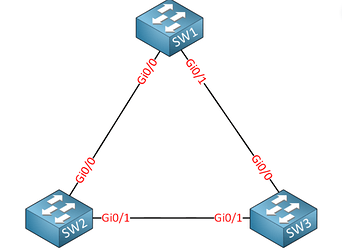STP - MST maps groups of VLANs
Multiple Spanning Tree is a type of Spanning Tree Protocol (STP) that is used to allow multiple VLANs to be mapped to a single spanning tree instance for the purpose of reducing the overhead on the network devices resulting in a more efficient use of network resources. This is particularly beneficial in environments that have dozens, hundreds, or even thousands of defined VLANs.
What does "mapping multiple VLANs to a single spanning tree instance" mean? Well, consider the following network topology:

There are only so many possible STP logical topologies that this physical topology can allow. For example, the possibilities are:
- SW1 is the root with Gi0/1 of SW2 as the blocked port
- SW1 is the root with Gi0/1 of SW3 as the blocked port
- SW2 is the root with Gi0/1 of SW1 as the blocked port
- SW2 is the root with Gi0/0 of SW3 as the blocked port
- SW3 is the root with Gi0/0 of SW2 as the blocked port
- SW3 is the root with Gi0/0 of SW1 as the blocked port
Now imagine that you have 100 VLANs configured on these switches. With PVST+ you will need 100 instances of STP. Those instances will necessarily match one of the above 6 logical STP topologies. That means that you will have multiple instances of the same logical STP topology.
MST groups VLANs that share the exact same logical STP topology, thus needing only 6 instances of STP rather than 100.
It is crucial that switches within a particular region maintain a consistent configuration regarding VLAN groupings on a per-instance basis.
Links
https://networklessons.com/spanning-tree/multiple-spanning-tree-mst/